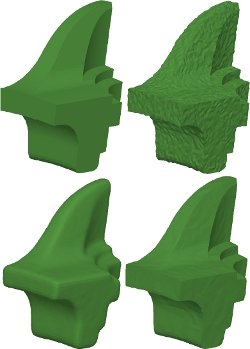Smoothing Surfaces with Corners

Posted August 2010
While visiting the IMA in early 2001, Tom Duchamp of University of Washington, a geometer who works in computer graphics, attended a talk by postdoc Selim Esedoglu on image denoising. He wondered if the denoising method that Esedoglu described, which preserves image edges, could be modified to smooth surfaces that have edges and corners. The two started worked on this problem at the IMA but were not able to make much progress.
Why is this problem important? In computer graphics, one often acquires 3D models using some form of scanning. The process can be noisy and often introduces artifacts which show up as bumps on the surface. The task of smoothing is to remove these bumps. There are many methods for smoothing. While they do remove the bumps, they also smooth the edges and the corners, thus artificially introducing inaccuracies in the process.
Nearly seven years later, Esedoglu, along with graduate student Matthew Elsey, came up with a definitive solution to the problem. The approach they take is to associate an "energy" with a geometrical object. The idea is that the desired smoothed object is one that minimizes this energy. To solve their problem, they applied tools from topology, which is the study of mathematical properties of objects that are preserved under deformation. In particular, the computational scheme they devised were inspired by fundamental theory from topology.